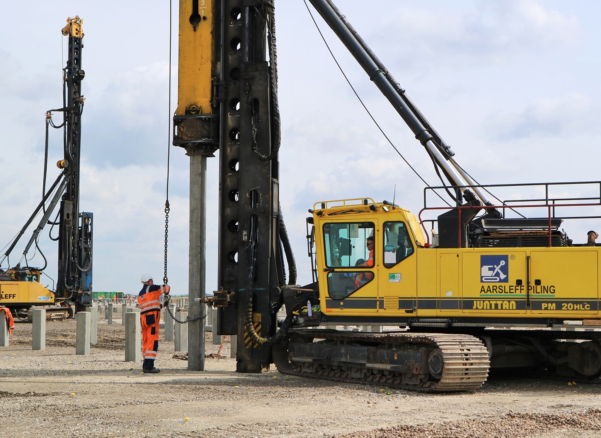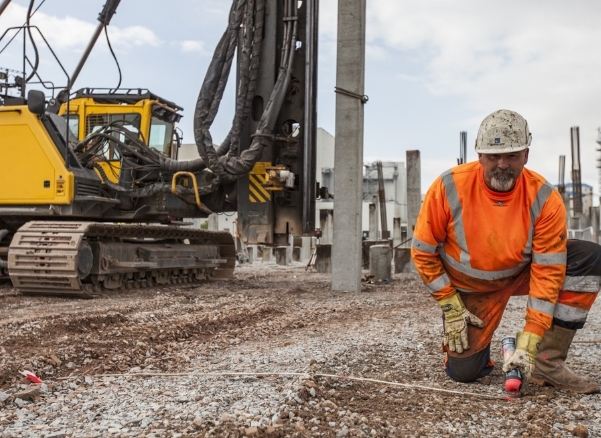The reuse of foundations for urban spaces
Categories:
Company NewsAarsleff Ground Engineering’s Dr Dan Adams provides GeoDrilling International with some considerations on employing foundation reuse in urban spaces.
In 2006, the ‘Reuse of Foundations for Urban sites’ (RuFUS) conference took place at the Building Research Establishment (BRE). Here, delegates learned that piling contractors would be put under increasing pressure to re-use existing foundations as part of the redevelopment of sites. On the back of this conference and in the same year, a best practice handbook entitled EP75: Reuse of foundations for urban sites, was published by the BRE.

EP75: Reuse of foundations for urban sites: Intended to provide an understanding of the background to foundation reuse as well as the key underlying issues. Presents advice on how to address risk through sound engineering principles and offers technical guidance on the processes for deciding on the correct foundation options. It also advises on investigation, design and construction using reused foundations.
Since then I believe that sustainability in the piling industry has moved forward considerably. This has been achieved with the use of replacement cementitious materials such as PFA or GGBFS, the use of recycled aggregates and BES6001 compliant responsibly sourced steel along with improvements to our plant and equipment and their emissions.
However, I’m not sure that the reuse of foundations has significantly increased. In 2006, the delegates at the conference were presented with survey results that indicated that between 15 to 30 per cent of piles were reused.
Have we as an industry managed to improve on these figures?
It is now 2020 and I have recently been involved in the development and pricing of a pile assessment and testing regime in order to examine the potential reuse of existing precast driven piles for the redevelopment of an owner-occupier’s site.
As part of a redevelopment, an owner-occupier may be more likely to employ foundation reuse. With fewer stakeholders, the owner-occupier may be willing to shoulder the risks associated with foundation reuse, more willing to commit greater funds to up-front investigation, and be able to manage the risks associated with project time or cost over-run. The blue-chip owner-occupier may also find the sustainability case attractive. However, there are several technical and commercial challenges to overcome before we can develop a risk/cost profile and make an appropriate assessment.
For this site, the ground is already congested due to some 300No. historical piles and services that are difficult to remove/move, hence consideration of reuse of the foundations. Fortunately, we have good ‘as-built’ records including locations, dimensions, type, materials and pile test data. For a piled foundation that has already been tested and ‘verified’ by the application of the first building load, a lower factor of safety against failure may be acceptable compared to that for new foundations, provided that enough details are known. A dispensation to the design team in respect of certain elements not being built to current codes may need to be accepted if this approach is adopted.

Aarsleff Ground Engineering installing reinforced precast concrete piles with its Junttan PMX 22
However, by testing some of the existing piles, the engineering behaviour and integrity of those piles tested can be confirmed and the results extrapolated across the remaining piles. The proposed test and inspection regime include a series of maintained static axial, tensile and lateral load tests on 11 of the 300No. piles (≈four per cent). These proposed test piles are located at five different areas across the proposed site to pick up differences in ground conditions, pile size etc.
Kentledge, while expensive, has been adopted over tension piles to provide reaction due to the congested nature of the existing piled foundations and the potential requirement for additional piles for the proposed development.
High strain dynamic testing was also considered, but our client’s designers wanted such tests calibrated by maintained static load tests so no advantage could be achieved.
However, the enabling works required to facilitate the testing are extensive; removal of existing pile caps (some up to 1.5m deep) both stitch drilling and hydro demolition have been considered rather than aggressive ‘breaker’ techniques which may have a negative impact of the integrity of underlying piles. Once the pile caps have been removed, we have to exhume the upper 1m of each pile to be tested to allow visual inspection and to undertake sonic echo pile integrity testing in order to assess the condition of pile shaft and length of pile below pile head. Finally, each test pile is to be extended back above ground level to allow static testing. The temporary works required to facilitate these preliminary activities are extensive.
The proposed pile testing is a significant commitment from our client both commercially and in terms of the programme for his project, indeed the development of the risk/cost profile can only be advanced once the test results are in. Meanwhile, there are also commercial matters relating to the provision of insurances and warranties that need to be addressed. For any foundation solution, there will be an ultimate client who wants protection for any failure by his designers, consultants and/or contractors. Even with a contract allowing the risks of reuse to be fairly assessed and distributed, a collaborative approach by the client, designer and construction team is required to make this option viable.
When evaluating different foundation options, the costs of the foundation construction should not be considered on their own but should be put into a larger context. Different levels of benefits associated with programme duration, construction safety and sustainability benefits had a significant effect on the total expected cost of the final foundations.
Pile reuse does have the potential to offer financial savings to a project, particularly when quality historical pile design and installation records are available. Benefits such as construction programme, construction safety and sustainability should also be considered. Any redevelopment project should undertake a site-specific assessment to identify the financial risks and opportunities that foundation reuse may offer.
About the author:
Dr Dan Adams is a Senior Geotechnical Consultant at Aarsleff Ground Engineering Ltd. With over 20 years within the industry, Dan has an extensive amount of experience and knowledge, from estimating and designing geotechnical solutions to successfully managing key geotechnical and geoenvironmental contracts. Dan has been key to the success of major UK and Ireland projects, including London Bridge Station Upgrade and Crossrail.
The Latest. News, podcasts & projects






